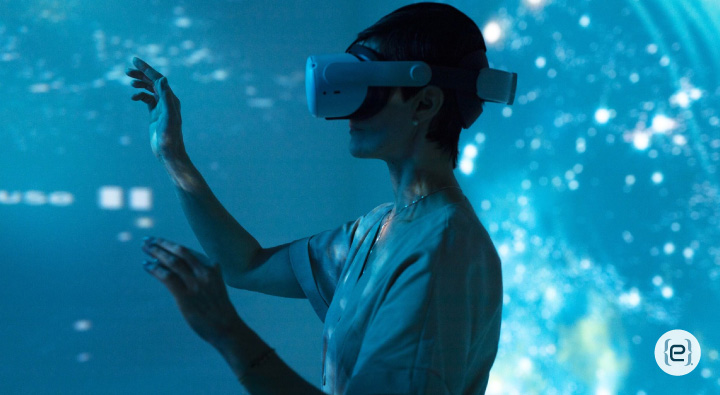VR Meetings: Handshakes and High-Fives in the Digital Realm


Virtual Reality Meetings: A New Era of Collaboration
Virtual reality meetings are taking the business world by storm. Gone are the days of staring at flat screens and struggling to read body language. Now, you and your colleagues can meet in immersive 3D spaces that feel almost like being in the same room. VR meetings allow your team to collaborate more effectively by providing a sense of presence and shared space that traditional video calls can’t match.
Companies like MeetinVR and Meta’s Horizon Workrooms are leading the charge in this exciting new frontier. These platforms let users join meetings as customizable avatars, share virtual whiteboards, and even access their real computers while in VR. It’s like stepping into the office of the future – no commute required!
While VR meetings may sound like science fiction, they’re quickly becoming a practical reality for many businesses. The technology is getting more affordable and user-friendly by the day. Who knows? Your next team brainstorm session might just take place on a virtual mountaintop or space station. The possibilities are as limitless as our imaginations.
Getting Started with VR Technology
Virtual reality meetings are becoming more common in workplaces. To join in, you’ll need the right gear and setup. Let’s look at the key things to get you started with VR technology for meetings.
Choosing the Right VR Hardware
Pick a VR headset that fits your needs and budget. Popular options include:
- Oculus Quest 2: Affordable and wireless
- HTC Vive Pro 2: High-end with great visuals
- HP Reverb G2: Good for business use
Think about comfort for long meetings. Look for adjustable straps and cushioning. Don’t forget controllers – they help you interact in VR spaces.
Some headsets need a powerful computer. Others work on their own. Check what your team uses to stay compatible. Make sure you have enough space to move around safely. Clear at least a 6×6 foot area for the best experience.
Essential VR Software for Effective Collaboration
Good VR meeting software is key. Here are some top picks:
- Glue: Great for team collaboration
- Spatial: Lets you work with 3D models
- AltspaceVR: Good for casual meetups
- Immersed: Focuses on productivity
These apps offer features like virtual whiteboards, file sharing, avatar customization, and screen sharing. Try out a few to see what works best for your team. Many offer free trials. Remember to practice using the software before your first big meeting. It might take time to get used to the controls.
Setting Up Your Virtual Meeting Space
Create a professional virtual office. Most VR meeting apps let you customize your space. Pick a calm background that won’t distract others. Set up virtual screens to share presentations, placing them where everyone can see easily. Arrange seating in a circle or U-shape to help everyone feel included. Add some fun elements like virtual plants or artwork, but keep it simple – too much clutter can be distracting.
Test your audio setup. Good sound is crucial for clear communication. Use a quality microphone if your headset’s built-in one isn’t great. Lighting matters, even in VR. Make sure your real-world space is well-lit so your camera can track your movements accurately.
Facilitating Virtual Reality Meetings
VR meetings bring unique opportunities and challenges. Success hinges on thoughtful preparation, engaging tools, and quick problem-solving.
Best Practices for Hosting VR Meetings
Set clear goals and agendas before the meeting. Choose a suitable virtual space that matches the meeting’s purpose. Brief participants on VR etiquette and controls beforehand. Test all equipment and software in advance, including headsets, controllers, and the VR platform itself. Start with a quick icebreaker to help everyone feel comfortable in the virtual space. It can be as simple as asking participants to customize their avatars or explore the room together. Keep meetings short, ideally under an hour, as VR can be tiring for some users. Plan regular breaks if longer sessions are needed. End with clear action items and follow-up plans. Just like in-person meetings, it’s crucial to summarize decisions and next steps.
Interactive Tools for Participant Engagement
VR conferencing has its own versions of how to keep attendees engaged. Virtual whiteboards let teams brainstorm ideas and sketch together. Great for visually-oriented thinkers, this board is ideal for creative sessions. With 3D models, sharing and manipulation can be done in real-time. This is perfect for design reviews or product demonstrations. Participants can examine objects from any angle they see fit, just like in real life. Polling tools retrieve quick responses during meetings. They can be used for making decisions by groups of people or to test understanding. Virtual sticky notes allow all participants to provide ideas simultaneously. Quite an entertaining way of gathering thoughts, rather than flowing with the conversation and speaking. Some of them offer “spatial audio,” meaning voices sound like they’re coming from where avatars are standing, making chats feel more natural.
Troubleshooting Common VR Hiccups
Technical issues can pop up in VR meetings. Be ready to help participants who struggle to join or navigate the virtual space. Keep a text chat open as a backup communication channel. It’s useful if someone’s audio fails or they need to step away briefly. Have a plan B, like a regular video call, in case of major VR platform outages. Motion sickness can affect some users. Encourage people to take breaks or switch to desktop mode if needed. Avatar glitches might occur. A quick re-login often fixes these visual bugs. Remind participants to charge their VR headsets before meetings. It’s no fun when someone’s battery dies mid-session!
VR for Small Businesses Communication
Virtual reality meetings are going to be an exciting possibility for small businesses. It has the ability to transform team connectivity and collaboration even when teams work remotely. The virtual space created by virtual reality makes your colleagues feel like they’re in the same room.
Small companies can use VR platforms to host team meetings, client presentations, and training sessions. Popular choices include MeetinVR and Glue, which are offering virtual conference rooms complete with tools like whiteboards. These meetings would also enable small businesses to conserve money on travel and office space. It also enables hiring talent anywhere, which could bring in a larger pool of candidates, too. Of course, VR adds that fun factor to things that can boost team morale and engagement.
Setting up a VR meeting isn’t as involved as you might think. The basic requirements of virtual meetings are:
- VR headsets-one for each participant
- Dependable internet connection
- VR meeting software
Yes, there’s an upfront investment, but for many small businesses, it pays off in spades with better communication and productivity. As the tech improves, the cost is also coming down. Of course, VR isn’t perfect in every situation. Sometimes a regular video call is perfectly fine. But when working in teams and building up a great team culture, VR truly is one unique way to achieve this with the immersive experience it offers.
The Future of Remote Collaboration
VR meetings are changing how we work together from afar. They bring new ways to connect and create, making remote work feel more real and lively.
Emerging Trends in VR Meetings
VR meetings are getting better all the time. Soon, we’ll see avatars that look just like us, with real facial expressions. This will make talks feel more natural. Voice tech is improving too, so we can chat in different languages easily. VR spaces are becoming more lifelike. Picture joining a meeting on a virtual beach or in a cozy cabin. It’s not just fun – it can spark new ideas and make people more creative. Teams will be able to work on 3D models together in real-time. Imagine architects tweaking building designs or doctors looking at scans side by side, even if they’re miles apart.
The Role of Augmented Reality in Hybrid Meetings
AR is bridging the gap between in-person and remote work. With AR glasses, people in the office can see virtual screens and objects that remote workers are looking at. This tech helps everyone feel like they’re in the same room. Remote folks can “sit” at the table as holograms, while office workers see them through AR lenses. AR can also show real-world info during meetings. Think about seeing live data floating next to products you’re discussing. Or watching a virtual demo of a new gadget right on your desk. As AR gets smaller and comfier to wear, it’ll become a normal part of our work day. It’ll make hybrid meetings smoother and help teams stay in sync, no matter where they are.
Wrapping Up with a Virtual Handshake
Ending a VR meeting on a positive note helps leave a lasting impression. A virtual handshake can add a personal touch and simulate real-world interactions.
Conclusion – The Takeaway
Virtual handshakes in VR meetings can take many forms. Some platforms let users high-five or fist-bump using hand controllers. Others use custom animations triggered by buttons or gestures. These digital greetings help build rapport and team spirit. They’re especially useful for remote teams who rarely meet in person. VR handshakes can feel surprisingly real with haptic feedback in gloves or controllers. To wrap up a VR meeting, leaders can encourage everyone to join in a group handshake or wave. This creates a sense of unity and closure. It’s a fun way to end on a high note and leave participants feeling connected.
Remember to thank everyone for their time and participation before the virtual handshake. This shows appreciation and professionalism in the VR workspace.
To explore how VR technology can enhance your business’s remote collaboration, contact eMazzanti today to learn how we can help you integrate this innovative solution into your workflow.
Recent Posts
Step Up Your Threat Response With Security Copilot
As we move deeper into 2025, you are probably focusing on ways to expand your…
Watch Out for the Cyber Security Menace
As we move deeper into 2025, you are probably focusing on ways to expand your…
The Rise of AI Agents: Simplifying Tasks and Connecting Technologies
Introducing eCare Bot: Your Intelligent IT Support Assistant In today's fast-paced world, the emergence of…
Server Simplified
At eMazzanti Technologies, we recognize that stable, effective, and expandable servers are essential to the seamless operation of enterprises. For this reason, we collaborate with Hewlett Packard Enterprise (HPE) to offer our clients the best server solutions possible, customized to meet their unique requirements. HPE servers provide the performance and flexibility required for small and big businesses to manage data, support apps, and manage workloads with ease. Customers may choose the best HPE servers for their organization with the assistance of our team of specialists. We take the time to comprehend the particular needs of every client, including those related to processing speed, storage capacity, and security features. Whether our clients require a general-purpose ProLiant server or a…
How to Make Your AI Copy Sound Authentic: Writing Like a Human, Not a Machine
AI writing tools have become popular for creating content quickly. But many readers can spot…
Data Analytics for Old-School Business Owners: Turning Dusty Ledgers into Gold Mines
Data analytics is changing the game for businesses of all types, including old-school industries that…


